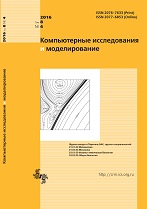|
ANALYSIS AND MODELING OF COMPLEX LIVING SYSTEMS
Molecular model of OCP-phycobilisome complex formation
D. V. Zlenkoa, I. N. Stadnichukb, P. M. Krasilnikova
a Lomonosov Moscow State University, 1/12 Vorobevy Gogy, Moscow, 11991, Russia
b A. N. Bach Institute of Biochemistry RAS, 33 Leninsky av., Moscow, 119071, Russia
Abstract:
A molecular model of phicobilisome complex with a quenching protein OCP which regulates the energy transfer from phicobilisome to photosystem in photosynthetic apparatus of cyanobacteria has been developed. In the model obtained a well known spatial structure of interacting proteins remains intact and also the energy transfer from phycobilisome to OCP with reasonable rates is possible. Free energy of complex formation was calculated using MM-PBSA approach. By the order of magnitude this energy is about tens of kJ/mole. This value correlates well with experimental observed low stability of this complex. The specific surface energy of interaction between hydrophylic phicobilisome and OCP is twice larger than specific surface energy of their interaction with water. This reflects a high molecular complementary of interacting protein surfaces and is a strong pro argument for proposed model.
Keywords:
OCP, MM-PBSA, phycobilisome, OCP, complexation, molecular modeling, free energy, MM-PBSA.
Received: 24.07.2014
Revised: 18.08.2014
Citation:
D. V. Zlenko, I. N. Stadnichuk, P. M. Krasilnikov, “Molecular model of OCP-phycobilisome complex formation”, Computer Research and Modeling, 6:5 (2014), 761–774
Linking options:
https://www.mathnet.ru/eng/crm357 https://www.mathnet.ru/eng/crm/v6/i5/p761
|

| Statistics & downloads: |
| Abstract page: | 127 | | Full-text PDF : | 55 | | References: | 29 |
|




 Contact us:
Contact us: Terms of Use
Terms of Use
 Registration to the website
Registration to the website Logotypes
Logotypes









 Citation in format
Citation in format 